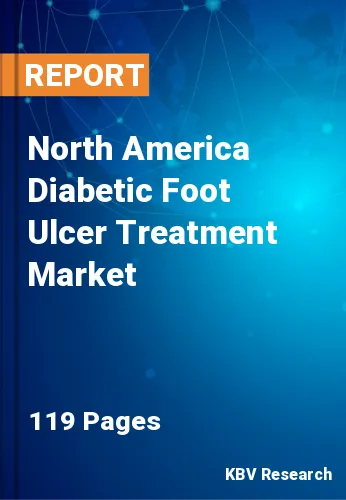The North America Diabetic Foot Ulcer Treatment Market would witness market growth of 4.5% CAGR during the forecast period (2023-2030).
The significant prevalence of diabetes among residents of industrialized countries has shown to have a vast potential for the market to treat diabetic foot ulcers. People's bad eating habits and rising sedentary behavior interfere with the body's ability to regulate glucose, leading to uncontrolled diabetes. This helps the market for enhanced treatment options for diabetic foot ulcers, which are expected to rise. The variety of services offered by the healthcare industry has increased the number of individuals choosing to get treatment for diabetic foot ulcers. These elements have given the sector several chances to experience significant expansion throughout the anticipated timeframe.
Obesity, long-term diabetes, peripheral artery disease, inadequate glycemic management, underlying neuropathy, or poor foot care are all predicted to raise the risk of diabetic foot ulcers (DFU), ultimately impairing mobility and resulting in lower limb amputation. It is believed that factors, including rising obesity rates and physical inactivity, contribute to the growth of diabetics. Diabetes that is not well controlled may cause foot sores that go untreated, blindness, renal failure, liver failure, cardiac arrest, and limb amputation.
As of June 2022, the CDC reported that 37.3 million Americans had diabetes, or 11.3% of the country's total population. 8.5 million people did not get a diagnosis, leaving 28.7 million with a diagnosis (23.0% of adults do not receive a diagnosis). Over 3 million Canadians have diabetes, and 200,000 new cases are diagnosed each year, according to the Canadian government, making it one of the most common chronic illnesses in the nation.
For research, monitoring, and prevention as well as to work toward the creation of a national framework for diabetes, Budget 2021 committed $35 million over five years. Mexico has 83,741,600 adults overall as of 2021, according to the International Diabetes Federation. Adults with diabetes accounted for 14,123,200 cases or 16.9% of the population. Diabetes foot ulcer prevalence is expected to grow along with the majority of diabetes, which will lead to a rise in the demand for the North American area.
The US market dominated the North America Diabetic Foot Ulcer Treatment Market by Country in 2022, and would continue to be a dominant market till 2030; thereby, achieving a market value of $1,649.4 million by 2030. The Canada market is experiencing a CAGR of 6.9% during (2023 - 2030). Additionally, The Mexico market would exhibit a CAGR of 6% during (2023 - 2030).
Based on Product, the market is segmented into Wound Care Dressings, Wound Care Devices (Negative Pressure Wound Therapy, and Others), Biologics, and Others. Based on Type, the market is segmented into Neuroischemic Ulcers, Neuropathic Ulcers, and Ischemic Ulcers. Based on End User, the market is segmented into Homecare Settings, Hospitals, and Others. Based on countries, the market is segmented into U.S., Mexico, Canada, and Rest of North America.
Free Valuable Insights: The Worldwide Diabetic Foot Ulcer Treatment Market is Projected to reach USD 6.5 Billion by 2030, at a CAGR of 5.2%
The market research report covers the analysis of key stake holders of the market. Key companies profiled in the report include Coloplast Group, B. Braun Melsungen AG, Integra LifeSciences Holdings Corporation, Smith & Nephew PLC, Cardinal Health, Inc., Medtronic PLC, 3M Company, Molnlycke Health Care AB, Essity AB and ConvaTec Group PLC.
By Product
By Type
By End User
By Country
Our team of dedicated experts can provide you with attractive expansion opportunities for your business.

